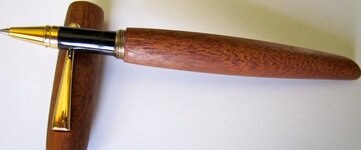Jjartwood
Member
when I was a young man (approx 8-10) my grandfather thought it time that I learned something about working with wood.The lessons were not fun as he was teaching me to work not play with wood,The thinking was later I found out that if things went bad on any level I could always build cabinets or something.
(He did quite well making liquor cabinets that looked like record player cabinets of the prohibition days)
Here are some of his techniques.
to get the blank round,find a heavy glass jar with alot of curves in it,smash it!
look thru the larger pieces of glass for a piece that closes matches the radius that you are looking for,start scraping.
*note.I did cheat and drill and tube blanks prior to this step.
When the shape is about as far as the "glass plane" can get it either find a tighter radius in the pile or break a smaller jar.
Once the desired shape is approximated than a dowel is inserted in the blank and a sponge (old time sanding block I would guess )is wrapped in sand paper I started at a buck and went up to 1000.
shaping the top and bottom are tricky so I wrapped a piece of masking tape around the blank to try and keep the dome and tail as uniform as possible
finishing was a matter of BLO and Butchers floor wax.
I know by today's standards the "glass plane technique" sounds crazy but I have run across some old timers that were very as a matter of fact about it and thought only an idiot didn't know about it.
Grab some gloves(which was unheard of when I learned it ) the type that won't let the glass slip in your hand and give it a try,if nothing else your concentrating so hard on not cutting yourself you don't even think about the days problems
Mark
(He did quite well making liquor cabinets that looked like record player cabinets of the prohibition days)
Here are some of his techniques.
to get the blank round,find a heavy glass jar with alot of curves in it,smash it!
look thru the larger pieces of glass for a piece that closes matches the radius that you are looking for,start scraping.
*note.I did cheat and drill and tube blanks prior to this step.
When the shape is about as far as the "glass plane" can get it either find a tighter radius in the pile or break a smaller jar.
Once the desired shape is approximated than a dowel is inserted in the blank and a sponge (old time sanding block I would guess )is wrapped in sand paper I started at a buck and went up to 1000.
shaping the top and bottom are tricky so I wrapped a piece of masking tape around the blank to try and keep the dome and tail as uniform as possible
finishing was a matter of BLO and Butchers floor wax.
I know by today's standards the "glass plane technique" sounds crazy but I have run across some old timers that were very as a matter of fact about it and thought only an idiot didn't know about it.
Grab some gloves(which was unheard of when I learned it ) the type that won't let the glass slip in your hand and give it a try,if nothing else your concentrating so hard on not cutting yourself you don't even think about the days problems
Mark


